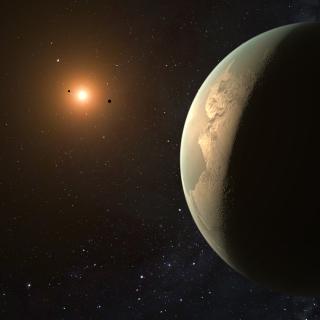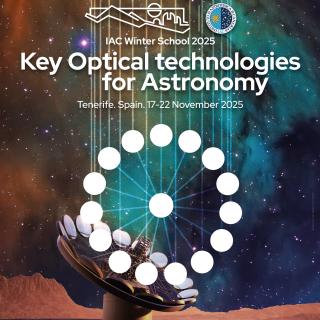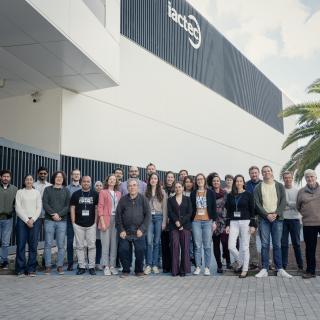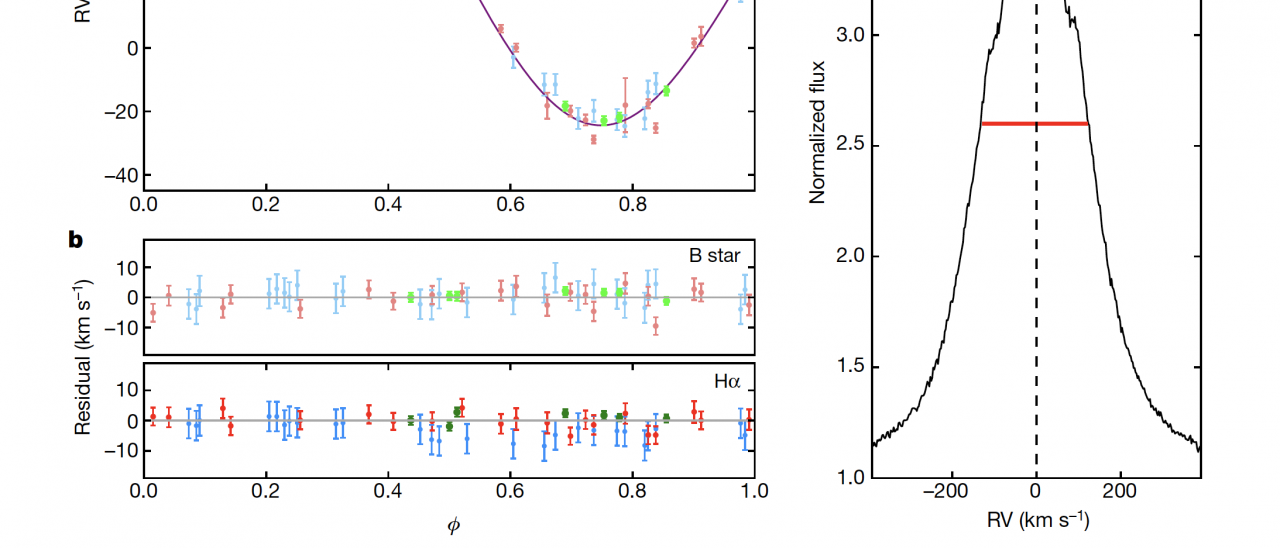All stellar-mass black holes have hitherto been identified by X-rays emitted from gas that is accreting onto the black hole from a companion star. These systems are all binaries with a black-hole mass that is less than 30 times that of the Sun. Theory predicts, however, that X-ray-emitting systems form a minority of the total population of star–black-hole binaries. When the black hole is not accreting gas, it can be found through radial-velocity measurements of the motion of the companion star. We report here radial-velocity measurements taken over two years of the Galactic B-type star, LB-1. The star was initially discovered during a monitoring campaign with the 4-m telescope LAMOST and subsequently studied in more detail with the 10-m class telescopes GTC and Keck. We find that the motion of the B star and a superimposed Hα emission line (see figure) require the presence of a dark companion with a mass of 68 solar masses, which can only be a black hole. The long orbital period of 78.9 days shows that this is a wide binary system. For comparison, black holes detected in X-ray binaries have masses in the range 5-15 solar masses. On the other hand, gravitational-wave experiments have detected black holes with several tens of solar masses. However, the formation of a ~70 solar mass black hole in a high-metallicity environment is extremely challenging within current stellar evolution theories. This would require a significant reduction in wind mass-loss rates and overcoming the pair-instability supernova phase, which limits the maximum black hole mass to less than ~50 solar masses. Alternatively, the black hole in LB-1 might have formed after a binary black hole merger or other exotic mechanisms.
a) radial velocity curves and orbital fits for the B-star (purple) and its dark companion (orange), the latter extracted from the wings of the Hα emission (panel c). b) Residuals obtained after subtracting the best orbital models from the velocity points.
It may interest you
-
 An international team, led by a student from Instituto de Astrofísica de Canarias (IAC), has detected a super-Earth orbiting in the habitable zone of GJ 3998, a nearby red dwarf located 59 ly away. The new planet, named GJ 3998 d, is the third planet found in the system. ‘GJ 3998 d is a welcome addition to the planetary census of our cosmic neighbourhood’, states Atanas Stefanov, a "La Caixa" funded PhD student at the IAC and the University of La Laguna (ULL) and the study’s lead author, published in Astronomy & Astrophysics . 'This super-Earth appears to be in the habitable zone of one ofAdvertised on
An international team, led by a student from Instituto de Astrofísica de Canarias (IAC), has detected a super-Earth orbiting in the habitable zone of GJ 3998, a nearby red dwarf located 59 ly away. The new planet, named GJ 3998 d, is the third planet found in the system. ‘GJ 3998 d is a welcome addition to the planetary census of our cosmic neighbourhood’, states Atanas Stefanov, a "La Caixa" funded PhD student at the IAC and the University of La Laguna (ULL) and the study’s lead author, published in Astronomy & Astrophysics . 'This super-Earth appears to be in the habitable zone of one ofAdvertised on -
 The Canary Islands Institute of Astrophysics (IAC) is organizing the XXXVI Canary Islands Winter School of Astrophysics , which will be held in San Cristóbal de La Laguna (Tenerife) from November 17 to 22, 2025. Under the title "Key Optical technologies for Astronomy", the school will focus on cutting-edge optical and algorithmic technologies that will define the future of Astrophysics. This edition, led by Professors Jeff Kuhn (University of Hawaii and IAC) and Rafael Rebolo (IAC), will involve approximately 35 advanced Master's students, doctoral candidates, and early-career postdoctoralAdvertised on
The Canary Islands Institute of Astrophysics (IAC) is organizing the XXXVI Canary Islands Winter School of Astrophysics , which will be held in San Cristóbal de La Laguna (Tenerife) from November 17 to 22, 2025. Under the title "Key Optical technologies for Astronomy", the school will focus on cutting-edge optical and algorithmic technologies that will define the future of Astrophysics. This edition, led by Professors Jeff Kuhn (University of Hawaii and IAC) and Rafael Rebolo (IAC), will involve approximately 35 advanced Master's students, doctoral candidates, and early-career postdoctoralAdvertised on -
 The Instituto de Astrofísica de Canarias (IAC) has been host to the Spanish ALMA Days 2025, which was held from 18th to 20th February in the IACTEC building in the Science and Technology Park at Las Mantecas (Tenerife). The aim of this event was to give information about the coming observation cycle of ALMA ( Atacama Large Millimetre/Submillimetre Array ) and to provide an overview of the data base of the telescope and its observing tools. In addition the scientific results of more than 10 years of observations were presented, and the future perspectives offered with the implementation ofAdvertised on
The Instituto de Astrofísica de Canarias (IAC) has been host to the Spanish ALMA Days 2025, which was held from 18th to 20th February in the IACTEC building in the Science and Technology Park at Las Mantecas (Tenerife). The aim of this event was to give information about the coming observation cycle of ALMA ( Atacama Large Millimetre/Submillimetre Array ) and to provide an overview of the data base of the telescope and its observing tools. In addition the scientific results of more than 10 years of observations were presented, and the future perspectives offered with the implementation ofAdvertised on
